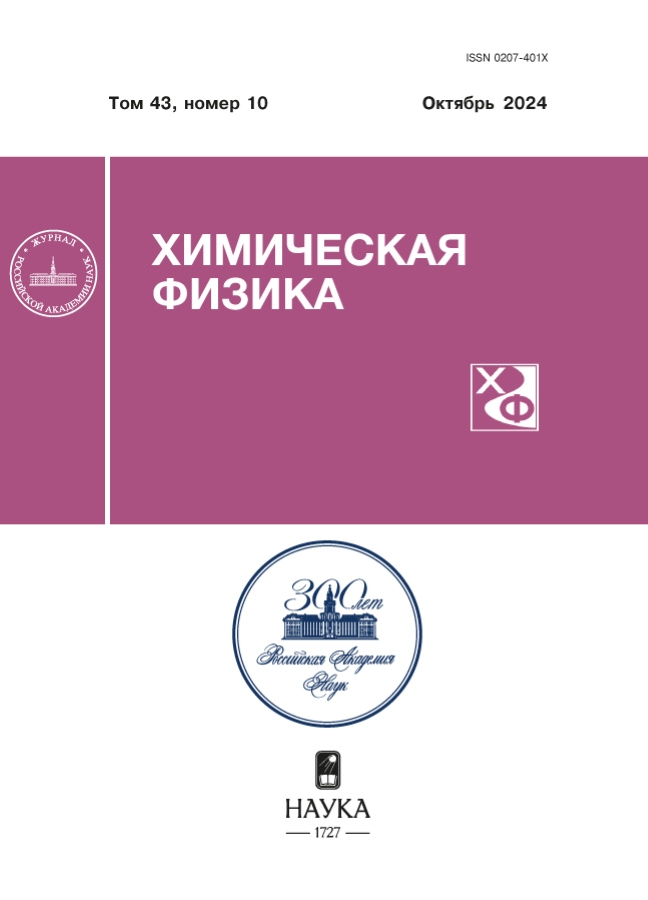Mechanism of nitrate formation in atmospheric haze particlesre
- Authors: Pronchev G.B.1, Yermakov A.N.1
-
Affiliations:
- Semenov Federal Research Center for Chemical Physics Russian Academy of Sciences
- Issue: Vol 43, No 10 (2024)
- Pages: 89-99
- Section: Химическая физика атмосферных явлений
- URL: https://medjrf.com/0207-401X/article/view/680955
- DOI: https://doi.org/10.31857/S0207401X24100089
- ID: 680955
Cite item
Abstract
The paper considers data on winter monitoring of the ionic composition of aerosol particles and small gas components in the surface atmosphere of Antwerp and Beijing. According to the results of their comparison, it is shown that the rapid accumulation of NO3- over Beijing in haze particles is triggered by a liquid-phase catalytic reaction of sulfate formation involving Mn/Fe ions, which proceeds in a fast degenerate branched mode. The cycle of these transformations is accompanied by the associated production of nitrate radicals in the particles. Their release into the gas phase leads to an increase in the concentration of N2O5 molecules, and a rapid accumulation of nitrates. The coupling of the catalytic (petrochemical) conversion of sulfur dioxide into sulfates and the nitrate production process over Beijing thus plays a crucial role in the formation of the mineral composition of haze particles in the atmosphere.
Full Text
About the authors
G. B. Pronchev
Semenov Federal Research Center for Chemical Physics Russian Academy of Sciences
Author for correspondence.
Email: pronchev@rambler.ru
Russian Federation, Moscow
A. N. Yermakov
Semenov Federal Research Center for Chemical Physics Russian Academy of Sciences
Email: pronchev@rambler.ru
Russian Federation, Moscow
References
- M.O. Andreae, C.D. Jones, P.M. Cox, Nature. 435(7046), 1187 (2005). https://doi.org/10.1038/nature03671
- J.H. Seinfeld, S.N. Pandis, Atmospheric Chemistry and Physics, from Air Pollution to Climate Change (John Wiley & Sons, Hoboken, New Jersey, USA, 2016).
- V.V. Zelenov, E.V. Aparina, Russ. J. Phys. Chem. B 16(6), 1182 (2022). https://doi.org/10.1134/S1990793122060239
- V.V. Zelenov, E.V. Aparina, Russ. J. Phys. Chem. B 17(1), 234 (2023). https://doi.org/10.1134/S1990793123010141
- A.A. Eganov, D.A. Kardonsky, I.V. Sulimenkov, et al., Russ. J. Phys. Chem. B 17(2), 503 (2023). https://doi.org/10.1134/S1990793123020240
- I.K. Larin, G.B. Pronchev, A.N. Yermakov, Russ. J. Phys. Chem. B 18(3), 675 (2024).
- C.M. Clark, D. Tilman, Nature. 451(7179), 712 (2008). https://doi.org/10.1038/nature06503
- Q. Zhang, X. Jiang, D. Tong, et al., Nature. 543(7647), 705 (2017). https://doi.org/10.1038/nature21712
- G. H. Wang, R. Y. Zhang, M. E. Gomes, et al., Proc. Natl. Acad. Sci. U.S.A. 113(48), 13630 (2016). https://doi.org/10.5194/acp-23-3015-2023
- P. Liu, C. Ye, Ch. Xue, et al., Atmos. Chem. Phys. 20(7), 4153 (2020). https://doi.org/10.5194/acp-20-4153-2020
- G. J. Zheng, F. K. Duan, H. Su, et al., Atmos. Chem. Phys. 15(6), 2969 (2015). https://doi.org/10.5194/acp-15-2969-2015
- Y. Pan, Y. Wang, J. Zhang, et al., Atmospheric Environment. 141, 197 (2016). https://doi.org/10.1016/j.atmosenv.2016.06.035
- M.-Y. Fan, Y.-L. Zhang, Y.-Ch. Lin, et al., Atmospheric Environment. 212, 96 (2019). https://doi.org/10.1016/j.atmosenv.2019.05.020
- H. Wang, K. Lu, X. Chen, et al., Environ. Sci. Technol. Lett. 4(10), 416(2017). https://doi.org/10.1021/acs.estlett.7b00341
- H. Wang, The chemistry of nitrate radical (NO3) and denitrogen pentoxide (N2O5) in Beijing. Springer Theses (Springer Nature Singapore Pte Ltd., 2021).
- Y. Sun, Q. Jiang,Z. Wang, et al., J. Geophys. Res. 119(7), 4380 (2014). https://doi.org/10.1002/2014JD021641
- G.J. Zheng, F.K. Duan, H. Su, et al., Atmos. Chem. Phys. 15, 2969 (2015). https://doi.org/10.5194/acp-15-2969-2015
- S.P. Sander, R.R. Friedl, D.M. Golden, et al., Chemical Kinetics and Photochemical Data for Use in Atmospheric Studies. Evaluation Number 15. JPL Publication 06-2(Jet Propulsion Laboratory. Pasadena. CA, 2006).
- A.N. Yermakov, A.E. Aloyan, V.O. Arutyunyan, G. B. Pronchev,Atmos Ocean Opt. 37, (2024). (in press)
- A.N. Yermakov, Kinet. Catal. 64(1), 74 (2023). https://doi.org/10.1134/S0023158423010019
- R.V. Grieken,Optimization and environmental application of TW-EPMA for single particle analysis (Antwerpen University, Antwerpen, 2005).
- M. Liu, Y. Song, T. Zhou, et al., Geophys. Res. Lett. 44(10), 5213 (2017). https://doi.org/10.1002/2017GL073210
- S. E. Schwartz, Gas–aqueous reactions of sulfur and nitrogen oxides in liquid-water clouds // SO2, NO and NO2 Oxidation Mechanisms: Atmospheric Considerations.Ed. by J. G. Calvert (Butterworth, Boston, 1984). p. 173.
- M. Z. Jacobsen, A. Tabazadeh, R. P. Turco, J. Geophys. Res. Atm. 101(D4), 9079 (1996). https://doi.org/10.1029/96JD00348
- T. Liu, S. L. Clegg, J. P. D. Abbatt, Proc. Natl. Acad. Sci. U.S.A. 117(3),1354 (2020). https://doi.org/10.1073/pnas.1916401117
- Y. Cheng, G. Zheng, C. Wei, et al., Sci. Adv. 2(12), e1601530 (2016). https://doi.org/10.1126/sciadv.1601530
- H. Herrmann, B. Ervens, H. - W. Jacobi, et al., J. Atmos. Chem. 36(3), 231 (2000). https://doi.org/10.1023/A:1006318622743
- M. D. Petters, S. M. Kreidenweis, Atmos. Chem. Phys. 7(8), 1961 (2007). https://doi.org/10.5194/acp-7-1961-2007
- C. Fountoukis, A. Nenes, Atmos. Chem. Phys. 7(17), 4639 (2007). https://doi.org/10.5194/acp-7-4639-2007
Supplementary files














